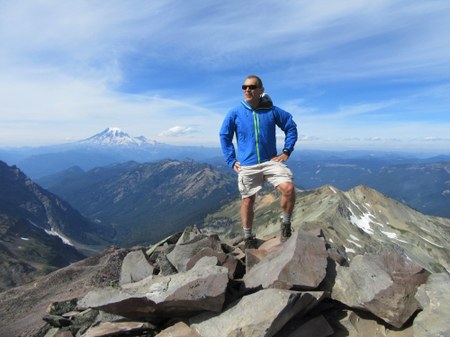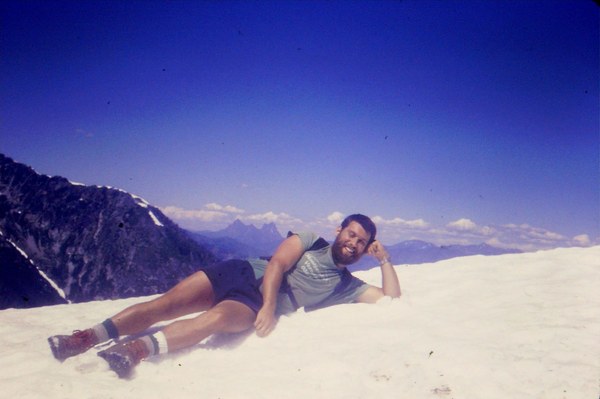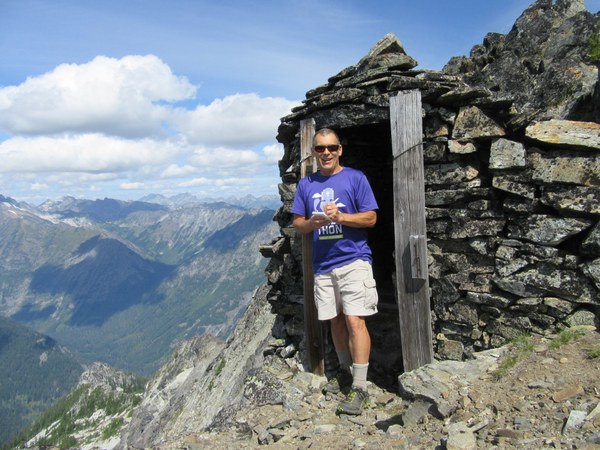
Hiking guidebooks and I go back a long time, long before I first set out with a notebook, pen, and camera to craft my own. In the early 1980s, after years as a road cycling fanatic (and fanatic I was, having biked across North America three times before my twenty-first birthday) I discovered the world of trails. A handful of hiking guidebooks helped me discover so many trails near and far: the AMC White Mountain Guide, 50 hikes in the White Mountains, and GMC’s Long Trail Guide, soon followed by many others.
As I broadened my sphere of places to hike, I liberally added guidebooks to my home library. I began planning trips to other parts of the country and beyond. In the process I acquired more books to help me find, appreciate, and assess trail choices across the globe. The better of these books went beyond trail logistics - they mentioned hiking etiquette and wilderness ethics, and promoted a strong conservation ethic. They encouraged their readers to get involved in saving and protecting the natural areas that these trails traversed. As I became a more avid and knowledgeable hiker, I grew to be a more concerned conservationist. I joined and supported hiking and conservation organizations in the places I lived, and often the places I visited as well.
In June of 1989 I moved to Washington. I had been here three times before - twice by bike. On the one trip that involved hiking, the guidebook I used was a small Sierra Club Tote Book on the North Cascades written by Fred Darvill. It whet my appetite to incredible trails to places like Sourdough Mountain, which remains one of my all-time favorite hikes. Upon living here (and intent on doing as much hiking as I could between work shifts and university classes) I realized my little tote book was not enough. I needed a far more comprehensive book or two. That’s when I discovered Harvey Manning and Ira Spring.
An indelible legacy
I picked up a copy of 100 Hikes in the Alpine Lakes by Manning and Ira and Vicky Spring and quickly realized it was exactly what I was looking for to guide me to the myriad trails in Seattle’s wild backyard. This book, however, wasn’t my introduction to (nor my first purchase from) Mountaineers Books. That honor would go to Isle Royale National Park Foot Trails & Water Routes by Jim Dufresne, purchased for my 1985 11-day backpacking trip in the wilderness area surrounding Lake Superior. That book earned my trust as an informative guide and introduced me to the quality outdoor resources published by Mountaineers Books.
Washington is a big state with many hiking trails, and I quickly kept adding more Mountaineers Books titles to my library: 100 Hikes in the South Cascades and Olympics, 100 Hikes in the North Cascades, 50 Hikes in Mount Rainier National Park, and 100 Hikes in the Glacier Peak Region - all by Manning and Spring. I fervently tried to get my money’s worth out of each book by completing as many of the hikes in each volume as possible!
My wanderlust for my new home kept growing, and I soon added 100 Hikes in the Inland Northwest and the Olympic Mountains Trail Guide to my collection too. I continued acquiring books as I explored areas in Washington and beyond. But no matter how far my feet carried me, one thing remained constant: the Manning and Spring titles stood out as my favorites.
 Sourdough Mountain, North Cascades National Park July
Sourdough Mountain, North Cascades National Park July
1985. Photo courtesy of Craig Romano.
Ironically, they weren’t the most descriptive of all the guidebooks I acquired. Many times Manning’s lack of details (which occasionally frustrated me) was supplanted by a historic tale, biting diatribe against shortsighted land managers and politicians, or cynical observations of how we were treating our natural heritage. This commentary is what made these books stand out and so much darn fun to read. While I might not have always agreed with the tone or delivery, I almost always agreed with the point. Manning didn’t pull any punches and he no doubt was a polarizing figure in a time when far more compromising was going on. In today’s culture of perpetual outrage, cultural relativism, and hyper-partisanship, I don’t think he would have reached as broad of an audience as he did then - and I am certain he wouldn’t have been as effective.
I admired Manning’s conviction and his unbridled love for our natural places. Yet he was (as we all are) a bit of an enigma, at times railing against trail crowding while selling tens of thousands of guidebooks. He definitely came across as an ideologue, elitist, or zealot at times. We can argue whether or not his was the right path for advocacy, but his path undoubtedly produced results. Today we live with his incredible legacy, which includes the establishment of the North Cascades National Park and the transformation of the Issaquah Alps into one of the greatest urban parks and trails networks anywhere.
Carrying the legacy forward
When I was brought onto Mountaineers Books to take over the helm that Manning and Spring established by upgrading and updating their 100 Hikes legacy into a new Day Hiking series, I accepted it as a huge challenge and an honor. It’s a privilege to be trusted to follow in their very large boot prints, and I accepted the challenge to produce well researched, trusted, informative, and entertaining books as they had. And in the process of it all I had to be sensitive to an outdoors culture that had changed - with new users, new uses, new relationships with the land, and new attitudes. I also had to be true to myself as someone who definitely saw things differently than Manning and Spring on many issues, but still shared some of their deeply held beliefs.
How would I pull that off? I decided to take a stealthier approach when I got on the soapbox - one far less combative,trying to understand and validate opposing views - and not denigrate those who hold different perspectives. Yes, I am compelled to take tough stands on issues from time to time. Like Manning, I too feel strongly and passionately about many issues affecting our trails and public lands. Yet I detest the divisiveness in today’s culture and try my darnedest to instead emphasize our commonality: a love for our public lands, trails, and natural heritage. I want to build an inclusive community of readers and defenders of our public lands. It is my biggest challenge as a guidebook author and one I continue to work on.
One of the biggest challenges I also face today is keeping guidebooks relevant and integral in this digital era. In Manning and Spring’s day, guidebooks were essentially the only show in town. Today, there’s no shortage of free hiking information available online. Much of it is crowd-sourced, cluttered, and questionable, and it’s designed for clicks to harvest your personal information and get you to buy something (nothing is free). Worst of all, much of this information regurgitates the same places and creates crowding, fails to mention pertinent information to keep the hiker safe, knowledgeable, and in compliance with regulations, and lacks any environmental ethos. This is where guidebooks shine. Their main focus is to give you solid trail information (not sell you outdoor gear), offer choices (not send you to the same sites for an overexposed photo op), and to bond you with the land to transform you into a protector and defender of our natural heritage (not a consumer of it).
As our trails and public lands have become more popular than ever, it’s vital that we reach as many people as possible and make sure they have the proper information available to be thoughtful trail users and enlightened stewards of our public lands. I have Manning and Spring to thank for helping me get there. Now it’s my turn to pay it forward.
 Throne of Stone on Mount David, Glacier Peak Wilderness August 2019. Photo courtesy of Craig Romano.
Throne of Stone on Mount David, Glacier Peak Wilderness August 2019. Photo courtesy of Craig Romano.
Craig Romano is an award-winning author who has written more than 20 books. His latest release, Urban Trails Tacoma (Mountaineers Books), highlights the best trails for walking, running and hiking in Tacoma, Puyallup, South King County, and Anderson Island. Some of his other titles includes; Urban Trails Seattle, 100 Classic Hikes Washington, and Day Hiking Olympic Peninsula (2nd edition).
MAIN IMAGE OF Old Snowy Mountain, Goat Rocks Wilderness Aug 2018. Photo by Suzanne Gerber.
This article originally appeared in our Summer 2020 issue of Mountaineer Magazine. To view the original article in magazine form and read more stories from our publication, visit our magazine archive.
 Craig Romano
Craig Romano